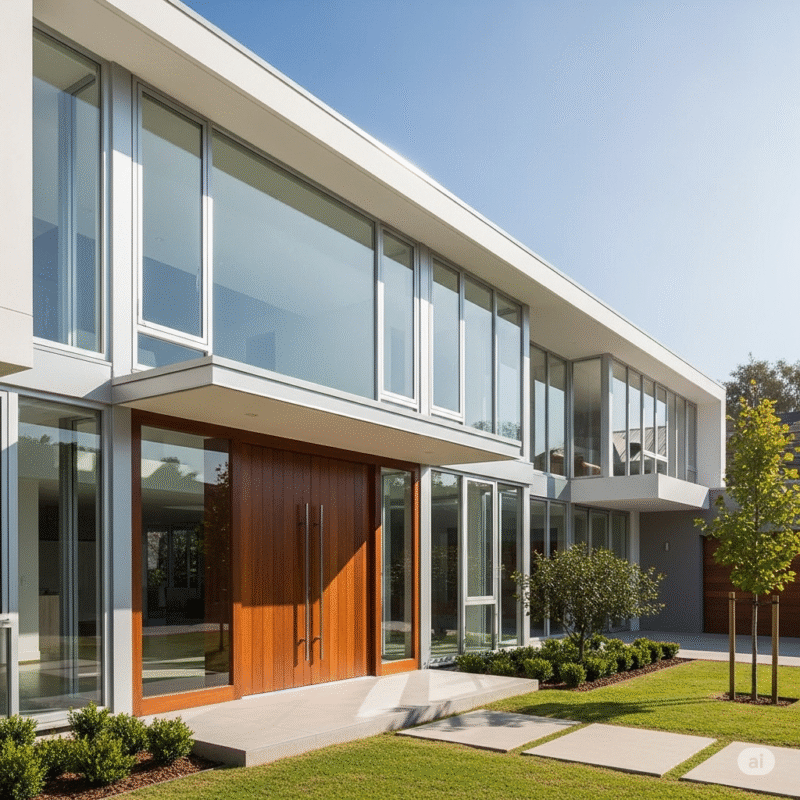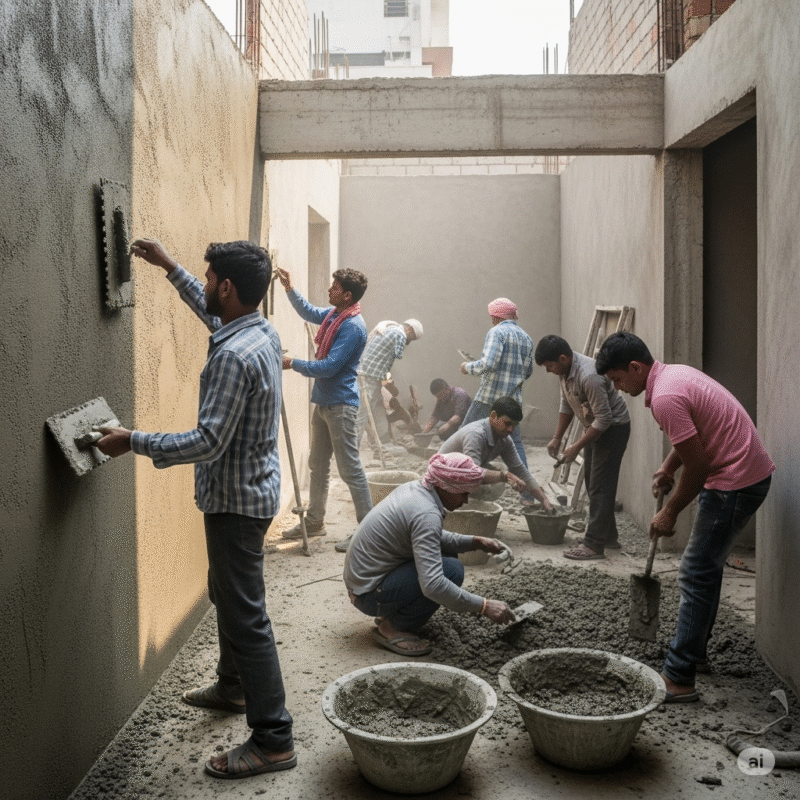Introduction
The aesthetic appeal and functional efficiency of any building significantly depend on its doors, windows, glazing, and metal works. These elements not only enhance the visual appeal but also contribute to the building’s energy efficiency, security, and comfort. This blog post delves into the intricate processes involved in executing these works across various construction projects in India, from residential buildings to commercial complexes and industrial facilities.
Whether you’re an experienced professional, a fresh graduate, a developer, or someone planning to build a home, understanding the life cycle of these components will help you make informed decisions and ensure quality outcomes for your project.

Understanding the Project Life Cycle
Before diving into specific elements, let’s understand the typical project life cycle for doors, windows, glazing, and metal works:
- Planning & Design Phase: Requirements gathering, material selection, design development
- Procurement Phase: Vendor selection, material ordering, quality verification
- Installation Phase: Site preparation, installation, quality checks
- Finishing Phase: Final adjustments, cleaning, handover
- Maintenance Phase: Regular inspection, repairs, replacements
Now, let’s explore each element in detail.
1. Doors
Key Methodologies in Door Installation
1.1. Planning and Selection:
- Determine door locations, sizes, and types based on architectural plans
- Select appropriate materials based on:
- Location (external/internal)
- Functional requirements (security, fire rating, acoustic properties)
- Aesthetic preferences
- Budget constraints
1.2. Material Options:
- Timber doors (teak, sal, meranti)
- Flush doors
- UPVC doors
- Aluminum doors
- Steel doors
- Fire-rated doors
- Acoustic doors
1.3. Installation Process:
- Frame installation
- Door hanging
- Hardware fitting
- Finishing (polishing, painting)
- Sealing and weatherproofing
Material and Manpower Requirements
Materials:
- Door frames and shutters
- Fixtures and fittings (hinges, handles, locks)
- Fasteners (screws, nails)
- Sealants and adhesives
- Finishing materials (polish, paint)
Manpower:
- Carpenter (skilled): 1-2 per door
- Helper (unskilled): 1 per carpenter
- Painter/Polisher: 1 for finishing work
- Supervisor: 1 for overall coordination
Typical Deliverables
| Project Stage | Deliverables |
|---|---|
| Design | Door schedule, specifications, drawings |
| Procurement | Material approval, vendor selection, samples |
| Installation | Installed doors, hardware fitment, functioning check |
| Finishing | Painted/polished doors, cleaning |
| Handover | Warranty documents, maintenance manual |
Key Stakeholders and Communication Matrix
| Stakeholder | Role | Communication Protocol |
|---|---|---|
| Architect | Design specifications, approval | Weekly meetings, RFIs |
| Project Manager | Coordination, timeline management | Daily updates, milestone reports |
| Contractor | Installation and execution | Daily site meetings |
| Supplier/Vendor | Material supply, quality assurance | Supply schedule, quality reports |
| Client/End User | Final approval, feedback | Milestone reviews, handover inspection |
| QA/QC Engineer | Quality checks, compliance verification | Inspection reports, checklists |
Relevant Standards and Compliance
- IS 1003: Timber paneled and glazed shutters
- IS 2191: Wooden flush door shutters
- IS 2202: Specification for wooden flush door shutters
- IS 4351: Specification for steel door frames
- IS 3614: Fire check doors
- IS 3809: Fire resistance test for structures
Door Installation Checklist
- Verify door locations as per drawings
- Check door frame alignment (vertical, horizontal, square)
- Ensure proper clearance between door and frame
- Verify hardware installation (hinges, locks, handles)
- Check door operation (smooth opening/closing)
- Inspect finish quality (no scratches, uniform paint/polish)
- Verify sealing around frame for external doors
- Confirm proper locking mechanism function
2. Windows
Key Methodologies in Window Installation
2.1. Planning and Selection:
- Determine window locations and sizes based on architectural plans
- Select appropriate window types based on:
- Ventilation requirements
- Natural light considerations
- Security needs
- Energy efficiency goals
- Aesthetic preferences
2.2. Material Options:
- Timber windows
- Aluminum windows
- UPVC windows
- Steel windows
- Composite windows
2.3. Installation Process:
- Frame installation
- Glazing installation
- Hardware fitting
- Weatherproofing and sealing
- Finishing
Material and Manpower Requirements
Materials:
- Window frames and sashes
- Glass (single or double glazed)
- Hardware (handles, stays, locks)
- Sealants and weather stripping
- Fasteners
Manpower:
- Window installer (skilled): 1-2 per window
- Helper (unskilled): 1 per installer
- Glazier: 1 for glass installation
- Supervisor: 1 for overall coordination
Typical Deliverables
| Project Stage | Deliverables |
|---|---|
| Design | Window schedule, specifications, drawings |
| Procurement | Material approval, vendor selection, samples |
| Installation | Installed windows, hardware fitment, weatherproofing |
| Finishing | Sealed windows, cleaning |
| Handover | Warranty documents, maintenance manual |
Key Stakeholders and Communication Matrix
| Stakeholder | Role | Communication Protocol |
|---|---|---|
| Architect | Design specifications, approval | Weekly meetings, design reviews |
| Project Manager | Coordination, timeline management | Progress reports, milestone reviews |
| Contractor | Installation and execution | Daily site meetings |
| Supplier/Vendor | Material supply, quality assurance | Supply schedule, quality certificates |
| MEP Consultant | Coordination with building services | Technical meetings, clash detection |
| Client/End User | Final approval, feedback | Milestone inspections |
Relevant Standards and Compliance
- IS 1038: Steel doors, windows, and ventilators
- IS 1948: Aluminum doors, windows, and ventilators
- IS 4351: Steel window frames
- IS 2835: Flat transparent sheet glass
- IS 875: Wind load calculations for windows
- IGBC/GRIHA: Energy efficiency requirements
Window Installation Checklist
- Verify window locations as per drawings
- Check frame alignment and squareness
- Ensure proper anchorage to structure
- Verify glazing installation and sealing
- Check hardware functionality (handles, stays)
- Test window operation (opening, closing, locking)
- Verify weather sealing around perimeter
- Confirm water drainage provisions
- Check for scratches or damage on glass and frame
3. Glazing Works
Key Methodologies in Glazing Installation
3.1. Planning and Selection:
- Determine glazing requirements based on:
- Safety considerations
- Thermal performance needs
- Acoustic requirements
- Solar control requirements
- Aesthetic preferences
3.2. Material Options:
- Float glass (clear, tinted)
- Tempered glass
- Laminated glass
- Double/triple glazed units
- Reflective glass
- Low-E glass
- Smart glass
3.3. Installation Process:
- Frame preparation
- Glazing bead/gasket installation
- Glass placement
- Securing and sealing
- Cleaning and inspection
Material and Manpower Requirements
Materials:
- Glass panels of specified type
- Glazing beads/gaskets
- Setting blocks and spacers
- Sealants (structural, weatherproof)
- Cleaning materials
Manpower:
- Glazier (skilled): 2-4 depending on panel size
- Helper (unskilled): 1-2 per glazier
- Supervisor: 1 for overall coordination
- Safety officer: 1 for large projects

Typical Deliverables
| Project Stage | Deliverables |
|---|---|
| Design | Glazing schedule, specifications, performance criteria |
| Procurement | Glass samples, material approvals, test reports |
| Installation | Installed glass, structure/weather sealing |
| Finishing | Cleaned glass, protection markings |
| Handover | Warranty documents, maintenance guidelines |
Key Stakeholders and Communication Matrix
| Stakeholder | Role | Communication Protocol |
|---|---|---|
| Architect | Design specifications, approval | Design review meetings |
| Façade Consultant | Technical specifications, performance validation | Technical submissions, shop drawings |
| Structural Engineer | Load calculations, safety verification | Design verification, test reports |
| Contractor | Installation and execution | Installation methodology, risk assessment |
| Supplier/Vendor | Material supply, quality assurance | Material test certificates |
| Safety Officer | Safety protocols, compliance | Safety inspections, training |
Relevant Standards and Compliance
- IS 2835: Flat transparent sheet glass
- IS 2553: Safety glass – specification
- IS 16240: Glass in building – safety related to human impact
- IS 11785: Low emissivity glass for buildings
- ASTM E1300: Standard practice for determining load resistance of glass
- IGBC/GRIHA: Energy efficiency requirements
Glass Selection Guide
| Application | Recommended Glass Type | Thickness | Key Considerations |
|---|---|---|---|
| Windows | Clear/Tinted Float, Low-E | 5-6mm | Light transmission, thermal performance |
| Doors | Tempered | 10-12mm | Safety, durability |
| Façades | Tempered, Laminated, Double-glazed | 6+6mm to 8+8mm | Wind load, thermal performance |
| Railings | Laminated | 10+10mm | Structural integrity, safety |
| Partitions | Tempered, Laminated | 8-12mm | Acoustic performance, privacy |
Glazing Installation Checklist
- Verify glass specifications match requirements
- Check edge condition of glass panels
- Ensure frame is clean and prepared
- Verify proper placement of setting blocks
- Check correct positioning of glass in frame
- Ensure proper gasket/sealant application
- Verify weathertightness of installation
- Check for distortion, scratches, or damage
- Confirm safety markings where required
4. Aluminum Composite Panel (ACP) Works
Key Methodologies in ACP Installation
4.1. Planning and Selection:
- Determine ACP requirements based on:
- Fire resistance needs
- Thermal performance
- Aesthetic preferences
- Budget constraints
- Maintenance considerations
4.2. Material Options:
- Standard ACP
- Fire-rated ACP (FR grade)
- Metallic finish ACP
- Solid color ACP
- Natural stone finish ACP
4.3. Installation Process:
- Structural frame installation
- Panel fabrication (cutting, folding)
- Panel mounting
- Joint sealing
- Finishing and cleaning
Material and Manpower Requirements
Materials:
- ACP sheets
- Aluminum framework
- Fasteners and brackets
- Sealants and adhesives
- Insulation (if required)
Manpower:
- Fabricator (skilled): 2-3
- Installer (skilled): 2-4
- Helper (unskilled): 2-3
- Supervisor: 1
- Safety personnel: 1 for high-rise installations
Typical Deliverables
| Project Stage | Deliverables |
|---|---|
| Design | Panel layout, specifications, connection details |
| Procurement | Material approval, color samples |
| Fabrication | Fabricated panels as per drawings |
| Installation | Installed panels, sealed joints |
| Finishing | Cleaned panels, protection removal |
| Handover | Warranty documents, maintenance guidelines |
Key Stakeholders and Communication Matrix
| Stakeholder | Role | Communication Protocol |
|---|---|---|
| Architect | Design specifications, color selection | Design review meetings |
| Façade Consultant | Technical specifications, validation | Shop drawing approvals |
| Structural Engineer | Support system verification | Load calculations, anchorage design |
| Contractor | Installation and execution | Method statements, schedules |
| Supplier/Vendor | Material supply, quality assurance | Material test certificates |
| Fire Safety Consultant | Fire safety compliance | Fire test reports, compliance certificates |
Relevant Standards and Compliance
- IS 14246: Continuously pre-painted galvanized steel sheets
- ASTM D1781: Climbing drum peel test for adhesives
- ASTM E84: Surface burning characteristics
- NBC 2016: Fire safety requirements
- NFPA 285: Fire test method for exterior wall assemblies
ACP Installation Checklist
- Verify panel dimensions match fabrication drawings
- Check supporting structure alignment and stability
- Ensure proper fixing of brackets and subframe
- Verify panel alignment and joint spacing
- Check panel flatness and absence of oil-canning
- Ensure proper application of joint sealants
- Verify proper flashing installation at critical junctions
- Check color consistency across all panels
- Confirm penetrations are properly sealed
5. Railings (MS & SS)
Key Methodologies in Railing Installation
5.1. Planning and Selection:
- Determine railing requirements based on:
- Safety requirements
- Aesthetic preferences
- Structural considerations
- Maintenance requirements
- Budget constraints
5.2. Material Options:
- Mild Steel (MS) railings
- Stainless Steel (SS) railings
- Glass railings with MS/SS supports
- Combination railings (metal and glass)

5.3. Installation Process:
- Layout marking
- Fixation point preparation
- Anchor installation
- Railing erection
- Baluster installation
- Handrail fitting
- Finishing and protection
Material and Manpower Requirements
Materials:
- MS/SS pipes and sections
- Glass panels (if applicable)
- Anchors and fasteners
- Welding consumables
- Finishing materials (paint, polish)
Manpower:
- Fabricator (skilled): 2-3
- Welder (skilled): 1-2
- Helper (unskilled): 2-3
- Painter (skilled): 1-2
- Supervisor: 1
Typical Deliverables
| Project Stage | Deliverables |
|---|---|
| Design | Railing layout, specifications, connection details |
| Procurement | Material approval, samples |
| Fabrication | Fabricated components as per drawings |
| Installation | Installed railings, secure anchoring |
| Finishing | Painted/polished railings, cleaned glass |
| Handover | Warranty documents, load test certificates |
Key Stakeholders and Communication Matrix
| Stakeholder | Role | Communication Protocol |
|---|---|---|
| Architect | Design specifications, approval | Design review meetings |
| Structural Engineer | Load calculations, anchorage design | Design verification reports |
| Contractor | Installation and execution | Method statements, schedules |
| Supplier/Vendor | Material supply, quality assurance | Material test certificates |
| Safety Officer | Safety compliance, load testing | Safety inspection reports |
| Client/End User | Final approval, feedback | Sign-off inspections |
Relevant Standards and Compliance
- IS 800: General construction in steel
- IS 806: Use of steel tubes in general building construction
- IS 1239: Mild steel tubes and fittings
- IS 4923: Hollow steel sections for structural use
- NBC 2016: Section on railings and guards
- IS 3809: Fire resistance test for structures
Design Basis Calculations for Railings
Load Calculations:
- Horizontal load: 0.74 kN/m (as per IS 875 Part 3)
- Vertical load: 1.5 kN point load (as per NBC 2016)
Anchor Calculations:
- Minimum embedment depth: 75mm
- Minimum edge distance: 75mm
- Number of anchors: 2 per post minimum
Material Specifications:
- MS pipes: Minimum yield strength 240 MPa
- SS rails: Grade 304 or 316
- Anchors: Minimum pullout strength 5 kN
Railing Installation Checklist
- Verify railing locations and heights as per drawings
- Check base plate/anchor preparation
- Ensure proper alignment of posts (vertical, spacing)
- Verify secure connection of balusters to handrail
- Check weld quality and finishing
- Ensure smooth surface finish without sharp edges
- Verify paint/polish quality and consistency
- Check stability and rigidity of installed railings
- Perform load testing where required
6. MS Works
Key Methodologies in MS Works
6.1. Planning and Selection:
- Determine MS work requirements based on:
- Structural needs
- Functional requirements
- Aesthetic considerations
- Budget constraints
- Maintenance requirements
6.2. Common MS Applications:
- Structural elements (beams, columns)
- Staircases
- Balconies and canopies
- Gates and grilles
- Truss systems
- Utility supports
6.3. Installation Process:
- Layout and marking
- Fabrication (cutting, drilling, welding)
- Surface preparation
- Installation and anchoring
- Alignment and adjustment
- Finishing (painting, protective coating)
Material and Manpower Requirements
Materials:
- MS sections (angles, channels, tubes, plates)
- Fasteners and anchors
- Welding consumables
- Primers and paints
- Anti-corrosion treatments
Manpower:
- Fabricator (skilled): 3-4
- Welder (skilled): 2-3
- Helper (unskilled): 4-6
- Painter (skilled): 2-3
- Supervisor: 1
- Safety personnel: 1-2
Typical Deliverables
| Project Stage | Deliverables |
|---|---|
| Design | Shop drawings, fabrication details, connection details |
| Procurement | Material approval, certificates |
| Fabrication | Fabricated components as per drawings |
| Installation | Installed MS works, secure connections |
| Finishing | Painted/coated surfaces, protection |
| Handover | Warranty documents, load test certificates |

Key Stakeholders and Communication Matrix
| Stakeholder | Role | Communication Protocol |
|---|---|---|
| Architect | Design intent, approval | Design review meetings |
| Structural Engineer | Load calculations, connection design | Design verification, test reports |
| Contractor | Fabrication, installation | Method statements, progress reports |
| Supplier/Vendor | Material supply, quality assurance | Material test certificates |
| QA/QC Engineer | Quality checks, compliance | Inspection reports, NCR closures |
| Safety Officer | Safety compliance | Safety inspections, training |
Relevant Standards and Compliance
- IS 800: General construction in steel
- IS 806: Use of steel tubes in general building construction
- IS 1239: Mild steel tubes and fittings
- IS 2062: Hot rolled medium and high tensile structural steel
- IS 814: Covered electrodes for manual metal arc welding
- IS 3600: Methods of testing fusion welded joints
- IS 1477: Code of practice for painting of ferrous metals
MS Works Installation Checklist
- Verify dimensions of fabricated components match drawings
- Check material specifications and quality
- Ensure proper alignment of components before welding
- Verify weld quality (no cracks, proper penetration)
- Check bolt/anchor tightness and proper installation
- Ensure proper surface preparation before painting
- Verify paint application (thickness, coverage)
- Check for structural stability and load-bearing capacity
- Ensure proper finishing and absence of sharp edges
Value Engineering Opportunities
For Doors
Alternative Materials:
- Substitute solid wood with engineered wood or veneered options
- Use hollow core doors for non-critical areas
- Consider factory-finished doors to reduce on-site painting costs
Standardization:
- Adopt standard door sizes across the project
- Use consistent hardware specifications for bulk procurement
Performance Optimization:
- Use acoustic doors only where necessary
- Limit fire-rated doors to required locations
- Consider composite door frames for external doors
For Windows
Material Selection:
- UPVC windows offer good thermal performance at lower cost than aluminum
- Consider composite window systems for better performance-to-cost ratio
Glazing Optimization:
- Use double glazing only where thermal performance is critical
- Consider using low-E glass instead of double glazing for moderate climates
Design Optimization:
- Standardize window sizes and types
- Optimize window-to-wall ratio for energy efficiency
For Glazing Works
Glass Selection:
- Use heat-strengthened glass instead of fully tempered where safety is not critical
- Consider laminated glass with PVB instead of acoustic glass for moderate noise reduction
Installation Methods:
- Use dry glazing (gaskets) instead of wet glazing (sealants) where appropriate
- Consider prefabricated glazing units to reduce on-site labor
Performance Optimization:
- Use selective coatings instead of tinted glass for solar control
- Optimize glass thickness based on actual wind load calculations
For ACP Works
Material Selection:
- Use FR grade ACP only where required by code
- Consider solid color panels versus metallic finish for cost savings
Installation System:
- Use pressure plate systems instead of structural silicone glazing where appropriate
- Consider rainscreen systems versus wet-sealed systems for better longevity
Design Optimization:
- Optimize panel sizes to minimize waste
- Simplify panel joint details to reduce fabrication costs
For Railings
Material Selection:
- Use powder-coated MS instead of SS for indoor applications
- Consider SS cladding over MS structure for cost optimization
Design Optimization:
- Simplify baluster designs and spacing
- Use standard sections and components
Fabrication Methods:
- Maximize factory fabrication to reduce on-site work
- Use mechanical connections instead of welding where appropriate
For MS Works
Material Optimization:
- Use appropriate steel grades based on actual load requirements
- Optimize section sizes through structural analysis
Fabrication Methods:
- Maximize shop fabrication versus site fabrication
- Use bolted connections where appropriate for easier assembly/disassembly
Protective Treatments:
- Use hot-dip galvanizing for external applications instead of painting
- Consider factory-applied powder coating for better durability
Case Study: Integrated Façade System for Commercial High-Rise
Project Overview
- Project Type: 20-story commercial building in Bangalore
- Challenge: Optimize façade performance while managing costs
- Scope: Design and installation of an integrated façade system including windows, glazing, and ACP cladding
Approach
Design Phase:
- Conducted climate analysis to determine façade performance requirements
- Used digital modeling to optimize window-to-wall ratio
- Selected high-performance double glazing for east and west facades
- Chose standard double glazing for north and south facades
- Integrated FR-grade ACP panels as spandrel elements
Procurement Phase:
- Standardized window sizes for bulk procurement
- Pre-qualified vendors based on testing and certification
- Conducted factory inspections for quality assurance
Installation Phase:
- Used modular installation approach
- Implemented strict quality control measures
- Conducted regular site testing for water penetration and air infiltration
Results
- Performance: Achieved 22% reduction in energy consumption compared to baseline
- Cost Efficiency: Saved approximately 15% through value engineering
- Timeline: Completed installation 3 weeks ahead of schedule
- Quality: Zero water leakage issues during monsoon testing
Key Learnings
- Early involvement of specialists (façade consultants, energy modelers) is crucial
- Standardization of components yields significant cost savings
- Performance testing at every stage prevents costly failures
- Integrated approach to façade design (considering all components together) offers better performance
Conclusion
The execution of doors, windows, glazing works, ACP, railings, and MS works forms a critical part of any construction project’s life cycle. By understanding the methodologies, material requirements, stakeholder interactions, and quality standards, project teams can ensure successful implementation of these elements.
For developers, engineering professionals, and first-time homebuilders, paying close attention to the planning, design, and quality control aspects of these works can significantly impact both the performance and aesthetics of the building. Value engineering opportunities, when applied thoughtfully, can optimize costs without compromising on quality.
Remember that compliance with relevant Indian Standards and building codes is not just a regulatory requirement but a guarantee of safety, performance, and durability for these critical building components.
References
- National Building Code of India 2016
- IS 800: Code of Practice for General Construction in Steel
- IS 2062: Hot Rolled Medium and High Tensile Structural Steel
- IS 1038: Steel Doors, Windows and Ventilators
- IS 2191: Wooden Flush Door Shutters
- IS 16240: Glass in Building – Safety Related to Human Impact
- ASTM E1300: Standard Practice for Determining Load Resistance of Glass
- CPWD Specifications for Civil Works




